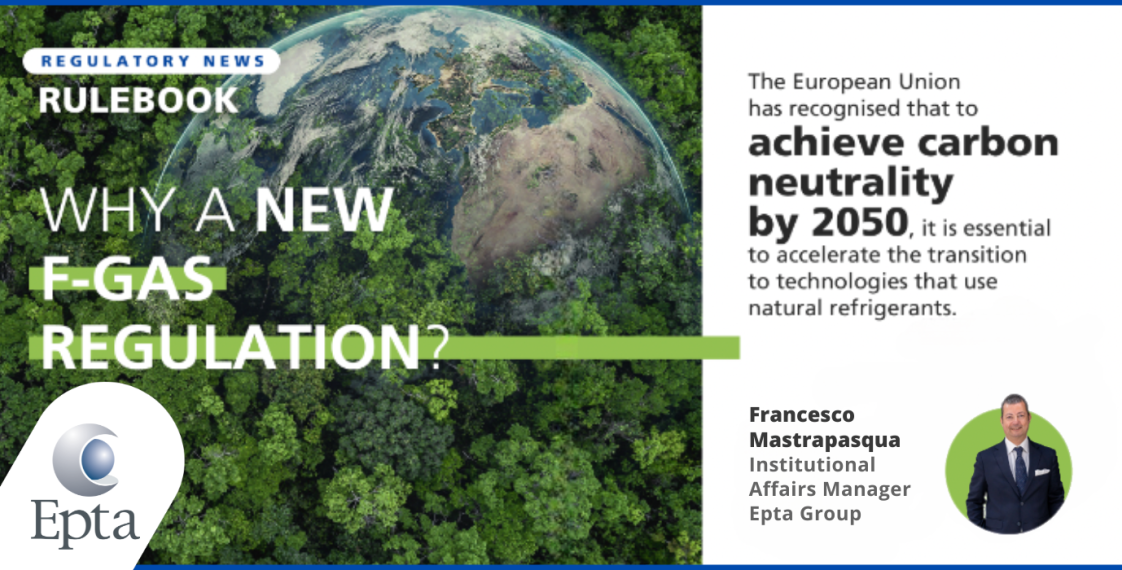WHAT IS THE NEED FOR A NEW F-GAS REGULATION?

Fluorinated gases are potent greenhouse gases (GHG) and emissions currently amount to 2.5% of the EU's total GHG emissions. In absence of restrictions the risk is an increase of 0.35-0.5°C in the global mean temperature by 2100. For this reason, since 2006 the EU has taken serious action by introducing regulatory measures to cut F-Gas emissions, in the frame of the EU's wider efforts to combat climate change.
The F-Gas Regulation (EU 517/2014) has worked relatively well and has succeeded to considerably reduce the use of fluorinated gases in line with its phase down schedule, i.e. two-thirds less by 2030 compared to 2014 levels. On the other hand, there were several shortcomings relating to the regulation itself and to its implementation, such as illegal HFC imports and insufficient monitoring, besides the fact that its scope was limited to 2030.
However, according to the European Environment Agency (EEA), demand for HFCs is decreasing, as EU industries have been gradually shifting to non-HFC alternatives with lower global warming potential, although the demand for refrigerants still remains high due to the maintenance of a huge number of stores relying on HFCs to continue to operate.
EU ON TRACK TO REDUCE HFC CONSUMPTION
The EU is on track to meet its international obligation to reduce HFC consumption under the Montreal Protocol but today the EU's increased climate goals require to accelerate the transition to F-Gas free technologies wherever possible.
The EU Green Deal targets carbon neutrality by 2050, specifying that all sectors must contribute to this target, and the Kigali Amendment committs all countries having ratified it to plan actions and introduce specific rules to reduce HFCs beyond 2030 and until 2050. Furthermore, recent technological development paves the way to further emissions savings in order to reach EU objectives more easily.
Finally, some changes to the former F-Gas regulation were needed to strengthen its implementation and enforcement, tackle the illegal trade of refrigerants and misuse of the quota system, ensure more comprehensive monitoring and better policy coherence, and to achieve more consistency and clarity in how the rules must be applied.
OBJECTIVES OF THE NEW F-GAS REGULATION: AN AMBITIOUS ACTION PLAN
Be that as it may, the main objective of the new regulation is to further cut F-Gas emissions with an increased ambition mainly through a steeper phase down of HFC quotas and a set of new product bans. A stricter and more ambitious legislation is crucial to make sure that European businesses and households are not burdened with a climate-damaging stock of equipment for decades to come, and to maintain global EU leadership in climate action by adopting best-in-class sustainable technological solutions.
Heat pumps, room air-conditioners, chillers, refrigeration appliances and systems using natural refrigerants are currently available on the market, with stationary refrigeration being “the low hanging fruit”, a sector that has already completely adapted its technologies and product portfolio to function fuelled by natural refrigerants, universally guaranteeing a high level of performance and efficiency even in the warmest climatic regions of Europe and without compromising safety.
The wide set of prohibitions contained in the new F-Gas, together with the steep HFC quota phase down (actually a phase out by 2050), leave space only for natural refrigerants in most of the sectors and send out a clear message to the market: environmental sustainability goes hand in hand with the gradual abandonement of fluorinated gases.
Promoting a direct shift to F-Gas-free solutions has been considered extremely important, in order to avoid intermediate alternatives and unlock the potential of innovative companies that have now been committing to innovative products and systems using natural refrigerants for several years.
The new measures are finally clear, administratively easy to implement and offer much less space for circumvention, resulting in the most effective framework to stimulate the green transition.
To sum up, the new F-Gas Regulation overseeds the limits of the previous one introducing:
• A steeper HFC quota phase-down schedule to meet Kigali Amendment targets
• New product bans for products containing or relying on fluorinated refrigerants
• Extension of leak checks requirements to HFOs and mobile equipment
• Requirement for leakage detection systems for equipment using high charge of F-Gases with alert systems in case of leakage
• Recovery obligations for all F-Gases in view of recycling, reclamation or destruction
• Extended Producer Responsibility: WEEE fees to include costs for recovery, recycling, reclamation and destruction
Similarly and more or less simultaneously, in the US the EPA has published the SNAP (Significant New Alternatives Policy), the Final Rules which restrict the use of HFCs introducing similar limits for new aerosol, foam, refrigeration, air conditioning, and heat pump products.